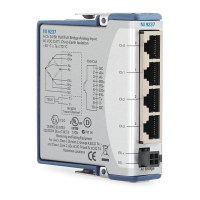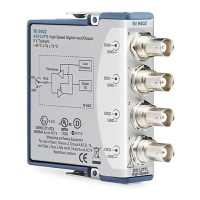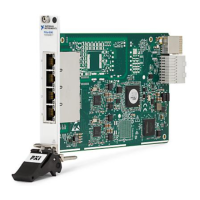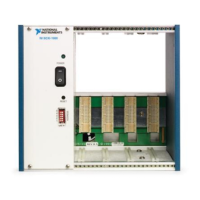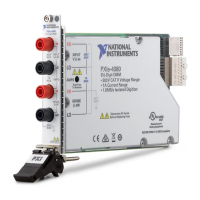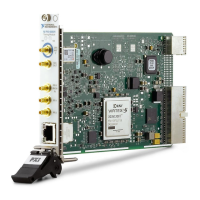FP-TC-120 and cFP-TC-120 8 ni.com
Alternative Cold-Junction Compensation
with the cFP-TC-120
If you are using an external terminal block or a cable backshell to
connect to the cFP-TC-120, you can compensate for cold junctions
by connecting a thermistor between pins 36 and 37. You must use
a thermistor with a resistance of 5 kΩ at 25 °C. Refer to the
Specifications section for information about the accuracy of the
thermistor in the cFP-CB-x connector block.
Software Cold-Junction Compensation
with the [c]FP-TC-120
The default setting is for the [c]FP-TC-120 to enable cold-junction
compensation for all temperature measurements. To disable this
feature and use a software algorithm instead, set the CJC Source
attribute of the CJ Temperature channel to either 0 or 25 °C.
Selecting one of these settings causes the [c]FP-TC-120 to assume
a cold-junction temperature of either 0 or 25 °C for all temperature
readings. Regardless of the setting of the CJC Source attribute, CJ
Temperature continues to reflect the actual measured temperature
of the terminal base or connector block. This method of software
cold-junction compensation is sufficient for applications in which
temperatures are fairly stable and uniform across the system.
Determining Measurement Accuracy
and Minimizing Errors
It is difficult to define temperature measurement errors in simple
terms because thermocouples are very nonlinear. The errors
depend in part on the thermocouple type, the cold-junction
temperature, the temperature being measured, and the accuracy
of the thermocouple. Also, it is important to distinguish between
absolute accuracy and resolution. Absolute accuracy (referred
to in this document as accuracy) is a measure of how far off a
measurement of the [c]FP-TC-120 is from the correct value.
Absolute accuracy includes all gain and offset errors, differential
and integral nonlinearity, quantization errors, noise errors, errors
in linearization algorithms, and errors in measurement of the
cold-junction temperature. Resolution refers to the smallest
measurable change in a value.

